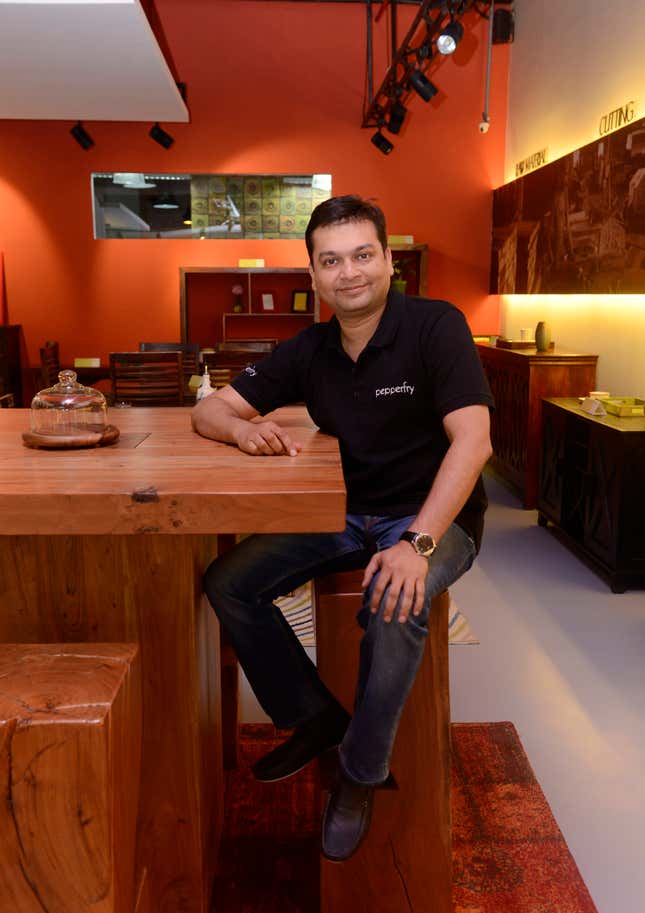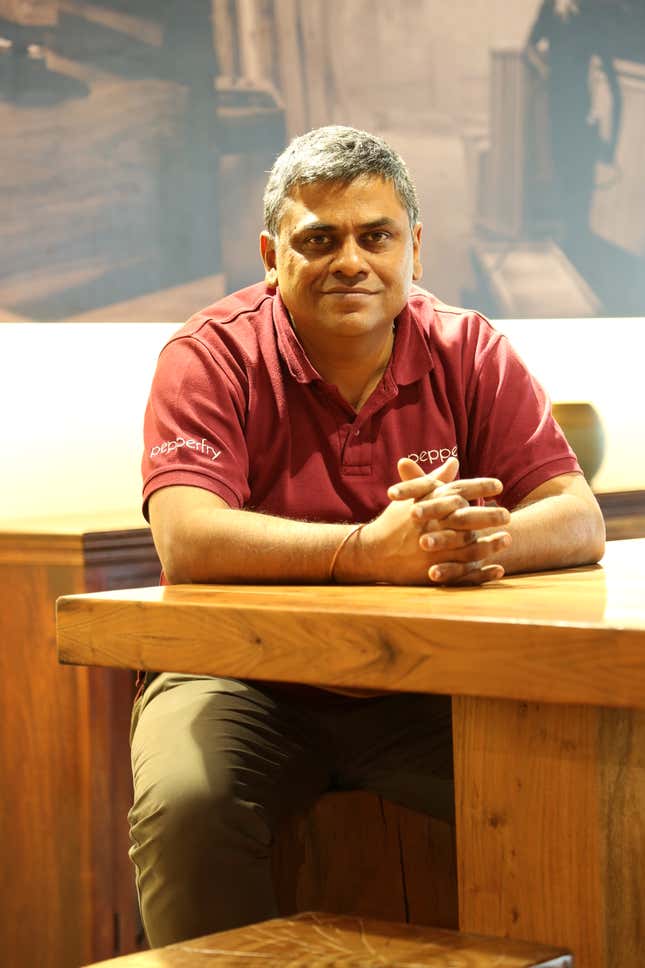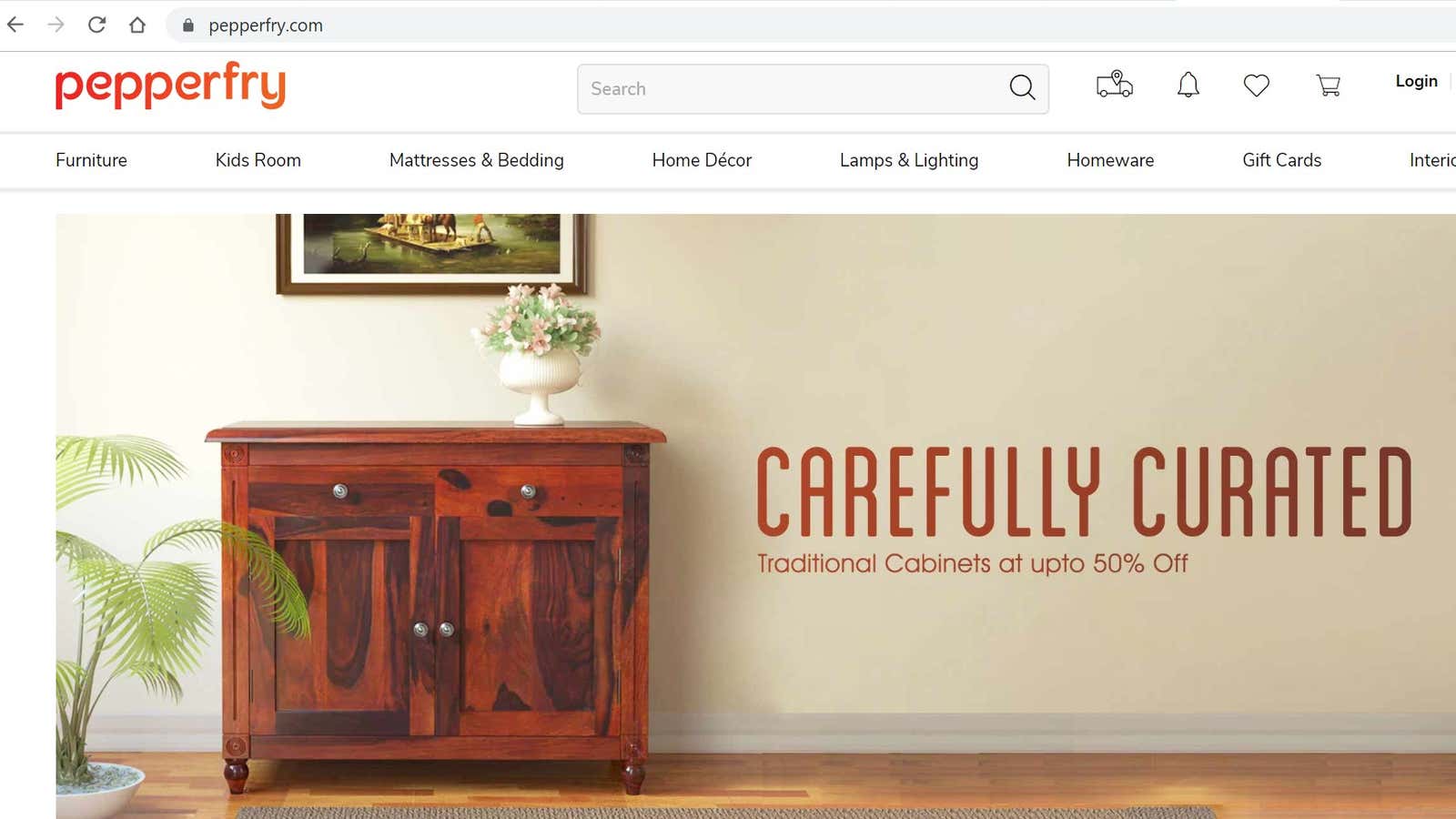Office parties are mostly about winding down. But at eBay India’s New Year party in 2010, two of the company’s top employees got talking business.
“Ambareesh told me he was thinking of leaving the job and starting something of his own, and I told him I also had something of the sort in mind. After some days we met again and decided that if we were both going to do something of our own, why not do it together?” said Ashish Shah, former business head for eBay motors and head of social shopping for US e-commerce giant. Ambareesh Murty, Shah’s boss, was the country manager for eBay India.
Over the next six months, the duo spent time finalising what their venture would be. They quit eBay in June 2011.
Now, Pepperfry is one of India’s leading online furniture retailing firms. The company is now reportedly valued at over $300 million (Rs2,1315 crore) and has raised over $200 million from investors such as Norwest Venture Partners (NVP), Goldman Sachs, and Bertelsmann India Investments. In the next year-and-a-half, the founders hope to turn Pepperfry profitable and take it public.
Shah spoke with Quartz India about the highs and lows of his entrepreneurial journey. Edited excerpts:
Ambareesh was the top guy at eBay, and you were among the top four people when you both quit the job to start Pepperfry. What led you to give up your cushy corporate careers and take a big risk?

I completed my engineering in 1998, post which I took up a job in a chemical trading company. I was in a hurry to start making money, so on weekends, I would do my own business of chemical trading. In 1999, I joined a company called ChemMe.com, which was India’s first online chemical trading market. This was way before people were buying books or clothes online. Since then, I have been working with dot com firms. In early 2002, I joined Baazee.com. In 2004-05, eBay acquired Baazee in India. I stayed on with the same company and in 2008, started reporting to Ambareesh.
We got along very well. We were the first people in office each day and the last ones to leave. At every party, we would be the last men standing. We became great friends despite the fact that both of us were very different from each other. What brought us together were our core values.
At the New Year’s party in 2010, Ambareesh told me that he was thinking of leaving the job and starting something of his own, and I told him that I also had something of the sort in mind.
At that time, e-commerce was happening in India but the supply chain around the businesses was fragmented. So, I was actually thinking of creating a logistics business, which would cater to all e-commerce companies. I shared my plans with Ambareesh and he told me about his plans for a marketplace. We decided that our ideas could come together and we could build a company.
You both quit your eBay jobs only in June 2011. What happened between December 2010 and June 2011?
By the end of April 2011, we had decided that we can work together. Then there were discussions about how much money we could pool in.
We were very ethical about this shift. We had decided a few things that we abided by completely. For instance, at the eBay office, we would only do what our jobs required us to and not discuss our venture. Also, we had decided that we would not hire anyone from eBay’s team for our new venture.
Around the end of May 2011, we had started going out in the market and pitching our venture to people. We had some good meetings, and NVP was very positive and told us that they could put in money. But we had already resigned without having a term sheet in hand. We had savings from our jobs, which we decided to put into this new venture.
June 17, 2011, was Ambareesh’s last day at eBay (I had been relieved a few days before him), and that’s when we officially started working on Pepperfry. The moment we updated our LinkedIn profiles, a lot of our old colleagues reached out to us. So the first few hires happened very easily via LinkedIn and we had around three employees within the first week.

What were the first few months after quitting from eBay like?
We spent July and August 2011 in getting our website and other technology developed by Pune-based Persistent Systems. Our company got incorporated on Aug. 30, 2011, and we had around 40 employees by then. We had hired a category team that would get us the first lot of products to be listed on the website. We had a chief technology officer join us in August-end.
During this time, we were spending our own money. So towards the end of August, we were left with only around Rs7 lakh.
Anyhow, we decided to take all of our 40 employees to Goa for an official outing. We thought that this was our last money and it will be spent like this. I remember, Ambareesh and I were on the flight to Goa and we were discussing that if anything happens to us, our families would have zero money.
But by the time we returned from Goa, we got our first $5 million funding.
Before we raised the first round, we would have spent close to Rs2.5 crore on Pepperfry. But we were one of the very few companies at the time that directly raised a series A round of $5 million. At that time, $5 million was a big deal. That money lasted us for a year and a half. In all, now we have raised about $215 million.
From that year till now, Pepperfry staff goes to Goa around August-September every year. Now we have around 600 people and we all still go.
Which were the roles you first hired for?
The key role at the beginning was to hire category managers because whether you’re a small shop or a big showroom, it is important that your shelves are first full. The other team we hired early on was the category management team. Often what happens is that you spend a lot of money on marketing but don’t have good products. So customers come, don’t like your products, and then never return.
Once those things were in place, we got in marketing folks. At the time of launch, we were about 85 employees. Today, we are 550 people, excluding the delivery staff. We have another 1,000 people on the delivery side, including 250 carpenters for assembly.
How did the name Pepperfy come about?
At the time of launch, we were a lifestyle business, which included apparel, jewellery, home decor, shoes, accessories, etc. We wanted to bring NGOs and artisans of India to an online marketplace.
For a name, we wanted to stick to our values, which were “Indian, honest, and exciting.” We thought spices are something that’s inherently India, especially pepper. But pepper alone could not be the name. So then we thought, when you fry pepper, it pops, and that is where the fun element gets added. That’s how we arrived at Pepperfry.
We also used to keep looking for domain names because that’s important in online businesses. Pepperfry.com was available at that time, so we registered that name. Pepperfry.com actually helped us start conversations. People would ask us about the name, and we could tell them about our business.
Also, we wanted to name our company such that it is extendable. For example, if I was called Furniture.com then I wouldn’t be able to sell something else today.
In November-December 2011, everyone started telling us that it sounded like the name of a food company. We used that to our advantage. When we had a work-in-progress website, we went to the founders of some iconic food joints in Mumbai, such as Britannia and Jai Hind, and interviewed them. We made those videos and put them online saying, “Pepperfry.com launching soon.” So we actually embraced the name and played along. When you’re starting up you have the liberty of making fun of your own self.
Do you remember when the website went live first?
On Dec. 23, 2011, we opened the website to our friends and family. The website was password protected and this was only to get feedback. On Jan. 3, 2012, we opened the website to customers. The first transactions started happening and those were amazing, crazy days.
For how long did you stay a lifestyle business, and when did the focus shift to furniture?
By February 2013, we had decided that we did not want to do other categories. We took a few months to transition and by April 1, 2013, we were a home and furniture business.
The lifestyle business did not work out the way we wanted it to. In a category like apparels, our goal was to get housewives, artisans, and people who do DIY stuff sell on our platform. We were also focused on building a marketplace business. We didn’t want to have inventories in our warehouses.
But around the same time, websites such as Jabong and Myntra were coming up and their business model was about getting brands online, booking their collections of the season and keeping an inventory. But in our case, once an order was placed, a small manufacturer would make it and we would supply. This meant our delivery timelines were between 7-15 days, and sometimes the colour would change if the same colour was not available.
By the end of December 2012, around 65% of our business was coming from furniture and home decor. So it was kind of a no-brainer to shift to this category.
How did you educate sellers and buyers who were not familiar to e-commerce back then?
So July 15, 2011, was when I went to Jodhpur for the first time. The first 50 suppliers out of the 150 that we have today were impaneled by me personally. I would meet them and explain to them what we were doing. They had no access to computers so we got them to buy their first computers.
Initially, when an order would come, my team would go to the seller and tell them that this product needed to be made. Also, we didn’t have orders at that time, so it was a big deal to convince them to wait for the day when some order would happen. At one point, we had 100 employees in Jodhpur who would manage suppliers, and sit in their factories to get the manufacturing done.
The customer part, we never really worried about. We are in a category that comes very late in the evolution of e-commerce. So our goal was to ensure that everyone who was online knows about Pepperfry. We did not have to enable the first online transactions as such.
Pepperfry launched just months apart from other competitors such as UrbanLadder, and FabFurnish. How did you take on the competition?
While we were all in the furniture space, all the companies that we are talking about were strategically very different. We are not a brand, we are a market. Most other companies in the segment are brands. On Pepperfry, from day one you could find brands like HomeTown, At Home, Neelkamal, etc. Even today, 50% of my business comes from the marketplace and 50% is from our own products. Our goal was to co-exist.
Did you ever think about your eBay job and feel that was better than the stress of entrepreneurship?
When you decide to become an entrepreneur, you start shifting your frame of mind accordingly. For instance, I would think that I might need to restart. I used to tell my family that you might need to take the bus again in life. Ambareesh had three cars during his eBay days. When we decided to start out, he sold all three and bought a new one because he felt he wanted something that was zero maintenance for a few years.
If you have a fallback plan then becoming an entrepreneur is very difficult because at the first challenge you would convince yourself to return.
Was there ever a time when you thought you would give up on Pepperfry?
Around 2012-13, there was a funding winter and no one was putting in monies. Things became very tough for us. That was the time when we had around 200 employees and we had to take a few big calls. What we did was that instead of firing people, we called all of our senior team—some 25 of us, including the co-founders—and we all took up to 70% pay cut. The beauty of that episode is that all of those 25 people who had taken the pay cuts are still with Pepperfry today.
The other challenge was when we pivoted to furniture, we started using third-party players for shipping, and around 20% of the time, the furniture would be broken and would come back. So we thought this was not working out. By mid-2013 we decided that we will build our own logistics business. That is when we bought 10 trucks. Today, we have 360 trucks and now none of my furniture items are touched by a third-party.
Do you think your corporate job helped you during your entrepreneurial journey? How?
The first thing you learn from a corporate job is an operating rhythm. This helps a lot when you are setting up your own company. By operating rhythm I mean, how you manage people, deal with them, talk to them, etc. As entrepreneurs, you are free to operate in your own way and you may choose to have ad hoc meetings or smoke conversations. While those are helpful, they don’t allow you to get into a rhythm.
Also, good corporates teach you a lot about structure. For example, we spend a lot of time on how we send out emails, how we communicate, etc. At Pepperfry, no one can send out an email with five different font styles and four different text colours. These may seem like very small things, but they help you run a company.
Don’t you feel some startup employees might want to work in a more casual and easy environment?
It’s not like we only follow processes. In our office, there’s no dress code. We have tonnes of entertainment-related stuff, and our parties are so wild that some venues have refused to host us again after the last party we had there.
But I feel most employees value learning things like how to communicate better, and how to plan better. These are things that they will need if they wish to assume leadership positions in the future.
What’s next for Pepperfry?
We believe that two things are going to drive our business going ahead: content (design inspiration) and virtual reality (VR).
Content will drive commerce going ahead, which means you need to invest a lot in cataloging, how you are showing your items, how you are describing them, etc. Also, in our minds in three to four years from now, people will buy using VR. They will go to a small 100 sq ft room, put on Google glasses, pick products and put them in the layout and checkout from there. So a lot of our time today is going into converting our existing catalogue into 3D models. Around 30% of the listings on Pepperfry today are already converted, so you can turn, tilt, rotate a bed before buying.
Also, eight years into the company, now we are absolutely focused on profitability. We are well on our path and we are very close, probably just nine to 12 months away at max. We want to save every bit of cost and we want to make every bit of margin. Our goal is to do an IPO in a year-and-a-half from now, and being profitable would be the first milestone for that.
